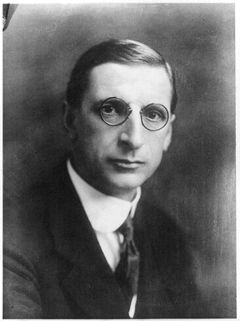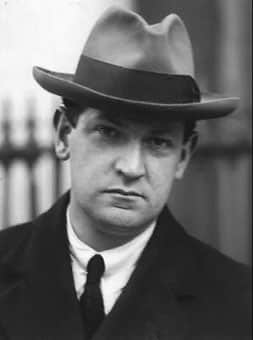There are many conditions under which Ireland was divided into two nations. Two main men were the main leaders of this split, Eamon de Valera and Michael Collins. Sinn Fein also played a large role. Their differing visions for an Ireland free of British rule was the root motivation for the split.
Born in New York City in 1882, Eamon de Valera was described as a ‘tall, spectacled, schoolmasterly, of Jewish cast’ as Tim Healy said. Edward Norman, the author of A History of Modern Ireland, added that de Valera was an ‘austere theoretician’ (Norman, 265). Michael Collins was born in 1890 at Clonakilty, Co. Cork.
Edward Norman said his personality was to be to the contrary of de Valera’s; he said Collins was not an intellectual and was a man of violent impulses. He took that statement further when he said the Collins would go as far as to tumble his colleagues on the floor and bite their ears in playful attention. Now that de Valera’s and Collins’ personalities have been established, we can now analyze the events and actual conditions under which Ireland was that led ultimately to her freedom.
All across Ireland people were repulsed by the executions which they considered to be needlessly brutal. What they lacked was new leadership to focus the restless energy of the Irish into effective political action, but it was not long in coming. At Christmas 1916 all rebel prisoners who had been interned without trial, those that the British had considered insignificant, were released as a goodwill gesture to the United States which had been very angry by British conduct regarding the rebels.
This proved to be a costly mistake. Among those released was a cadre of IRB men who had spent their time in prison educating and organizing themselves into what came out to be a formidable political and military force. The leader of these efforts in prison was Michael Collins, who was still a little-known Volunteer at the time.
Despite martial law, Collins contacted the members of his secret organization throughout Ireland and set in motion a clever plan to obtain political power. Using Sinn Fein as cover, the IRB began to run its members as candidates for parliament. Their successes throughout 1917 against Redmond’s Irish Parliamentary Party candidates shifted power to Sinn Fein and caused a turmoil of public support for the republican movement throughout Catholic Ireland.
After Collins’ release in June, 1917, Eamon de Valera, the oldest of the surviving 1916 rebels, joined Collins. De Valera was lucky for he had been spared by the British because of his American citizenship. De Valera was a hero to the Irish and he was elected as MP in July. In October he was elected president of both Sinn Fein and the Irish Volunteers. Sinn Fein became popular amongst the people.
In September the death of Thomas Ashe, a released 1916 rebel and close associate of Collins who had again been arrested for sedition had also contributed to Sinn Fein’s popularity was. Ashe went on a hunger strike while in a British prison and had died from injuries he received when prison authorities tried to force-feed him. Collins turned Ashe’s funeral into an enormous production that glorified the republicans and demonized the British. This in turn established a tradition of using funerals as propaganda ceremonies.
In 1918, two British ‘fools’, as put by Tim Pat Coogan, handed Sinn Fein more political capital than the ‘propaganda bonanza’ of Ashe’s funeral. As World War I was continuing, Britain needed more troops to send off to fight in Europe. Unable to recruit or draft enough men from the rest of the Empire, the British announced in April that she would extend conscription (drafting Irish people to fight) to Ireland. The Irish were outraged. Huge protests erupted.
Trade unions called for a general strike, all political parties, except for the Protestant Unionists, spoke against the draft, and the Irish Parliamentary Party MP’s withdrew from the House of Commons. The British dropped the Irish draft but did so too late to satisfy the republican and nationalist feelings.
Having miscalculated on the draft, the British further alienated republican sentiment when it appointed a military ‘viceroy’ to govern Ireland under martial law, claiming it was nebulous evidence that Sinn Fein was conspiring with Germany. Sinn Fein was outlawed and hundreds of Irish nationalists, including de Valera, were arrested. This was more than the Irish could handle.
In an unhappy coincidence for the British, the first General Election to be held in 8 years was scheduled for December 1918. Sinn Fein ran a full slate of candidates for the 105 open seats. Through a combination of successful campaigning, hard work, chicanery, voter fraud, and genuine heartfelt support, Sinn Fein won an outstanding 73 seats in Parliament. Among the newly elected MP’s were men who were held in prison and others who were on the run as wanted men.
Rather than go to Parliament, however, the 27 MP’s who were not in jail gathered in Dublin on January 21, 1919, where they constituted themselves as the Dail Eireann, the Assembly of Ireland, and then declared the formation of an independent Irish Republic. On that very day, the first two murders of Royal Irish Constabulary (RIC) members by Volunteers took place in County Tipperary. From then on for the next few years, ruthless violence would be brought along with the creation of the Republic.
At the second session of the Dail, Collins was elected Minister of Finance, and de Valera, only recently freed from jail in a daring escape masterminded by Collins, was elected President. While Collins remained in Ireland to oversee the management of the infant Republic, de Valera traveled to America to raise desperately needed funds and to try to influence the United States to formally recognize the Republic.
In September during de Valera’s absence, the British outlawed the Dail and began to crack down on Sinn Fein in a futile but bloody attempt to regain control over Ireland. Collins responded to this by reconfiguring the Volunteers into the Irish Republican Army, the IRA. Not clearly under the control of the Dail, but definitely following the orders of Collins, the IRA carried out a program of terror and assassination directed at the RIC. The RIC struck back with great ferocity but the IRA kept intimidating the RIC so the British began to lose control of the situation.
Determined to prevail, the British responded by reinforcing the rapidly thinning RIC ranks with British troops whose hastily supplied and mismatched uniforms gave them the unforgettable name of the Black and Tans. To supplement these new RIC members, Britain also began recruiting decommissioned British war veterans to form a special Auxiliary Force. Eventually, the British forces assembled against the republicans who had 50,000. Together these proved lethal opponents to the IRA in what rapidly degenerated into a bloody guerrilla war in which hundreds died on each side from bombings, shootings, burnings, and torture.
Relations between the British and the nationalist Irish were permanently scarred by a nasty cycle of attacks in which intentional brutal massacres of combatants were punctuated by episodes of inhuman treatment of non-combatants as well. The level of violence inflicted during 1920 was so extreme with neither side able to prevail that both the British and the Irish began to recognize they were trapped in a bloody stalemate. Thus, Ireland was granted her initial wish of existing free of British rule. Consequently, the nation was divided into two nations.


